Once the molecule file is fully loaded, the image at right will become live. At that time the "activate 3-D" icon ![]() will disappear.
will disappear.
Diatomic Oxygen Molecule
O2
O2 is a diatomic molecule consisting of two oxygen atoms that are double bonded together. Apart from being a crucial molecule for our continued survival, it has a multitude of other interesting characteristics. The O2 molecule was first modeled in Avogadro software, which was then loaded into MacMolPlt where 2 different input files were created, one for a UHF optimization and one for an RHF optimization in the Hessian 6-31G calculation. Because O2 has unpaired electrons in its veilance shell, it is possible to have a different number of degenerate states depending on the spin of each electron in the unbound orbitals. Each file was then sent to GamessQ which transferred the file to GAMESSUS which ran all of the optimization calculations. This yielded a lower energy in the UHF file meaning that there was multiplicity between orbitals in the O2 molecule. The UHF optimization was subsequently used to perform the CCD and CCT calculations in order to achieve the optimal geometry for this molecule.
Click the link below to see the O2 molecular surface
The O2 molecule's surface is uniform due to the high level of symmetry in diatomics.
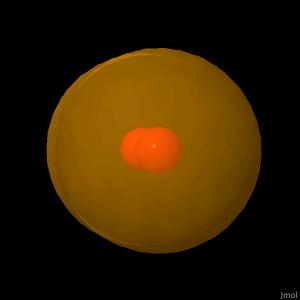 |
| O2 molecular surface |
The O2 molecule's surface is uniform due to the high level of symmetry in diatomics.
Click the button below to see the O2 bond-length
The O2 molecules bond length was found using the CCT calculation to generate the lowest energy state for this diatomic molecule. Its was measured to be 0.116 nm from the centers of the oxygen atoms. Similar measurements were found in the NIST Chemical Workbook1 with distances being measured at 0.1085 nm in the lowest measured state. Because this molecule is a linear diatomic, the bond angle between the two atoms is 180.0 degrees.
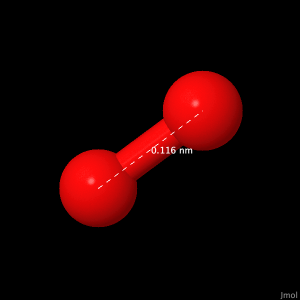 |
| O2 bond-length |
The O2 molecules bond length was found using the CCT calculation to generate the lowest energy state for this diatomic molecule. Its was measured to be 0.116 nm from the centers of the oxygen atoms. Similar measurements were found in the NIST Chemical Workbook1 with distances being measured at 0.1085 nm in the lowest measured state. Because this molecule is a linear diatomic, the bond angle between the two atoms is 180.0 degrees.
Click the button below to see the highest occupied molecular orbital for O2.
The highest occupied molecular orbital, or HOMO for short, shows the highest orbital that the molecules electrons will occupy while it is in the ground state. These orbitals were also calculated from the CCT generated model of the molecule. It shows two interacting P_z orbitals in the anti-bonding configuration.
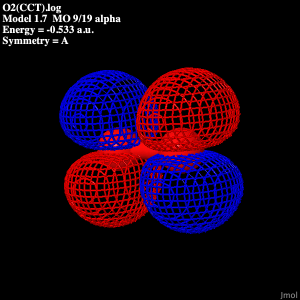 |
| O2 HOMO |
The highest occupied molecular orbital, or HOMO for short, shows the highest orbital that the molecules electrons will occupy while it is in the ground state. These orbitals were also calculated from the CCT generated model of the molecule. It shows two interacting P_z orbitals in the anti-bonding configuration.
Click the button below to see the lowest unoccupied molecular orbital for O2
The lowest unoccupied molecular orbital, or LUMO for short, shows the molecular orbitals that are just higher in energy than the HOMO. The LUMO in this case is the result of 2 P_x orbitals in the anti-bonding configuration.
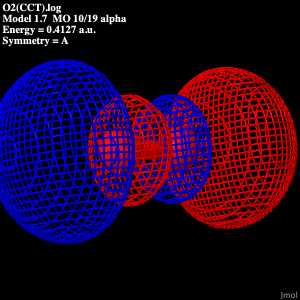 |
| O2 LUMO |
The lowest unoccupied molecular orbital, or LUMO for short, shows the molecular orbitals that are just higher in energy than the HOMO. The LUMO in this case is the result of 2 P_x orbitals in the anti-bonding configuration.
Click the button below to see the Vibrational modes for O2
O2 has one vibrational mode that consists of a stretching vibration at 1970.63 cm^-1. Although this vibrational mode is not IR active, it is RAMAN active because it changes the polarizability of the molecule. Other Sources2 have listed the molecule’s vibrational frequency as 1261 cm^-1
Click here to see the O2 Veilance Electrons Diagrams
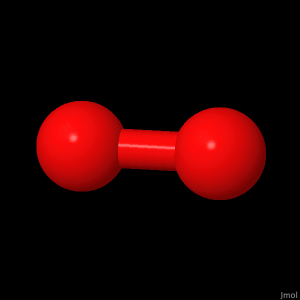 |
| O2 Vibrational modes |
O2 has one vibrational mode that consists of a stretching vibration at 1970.63 cm^-1. Although this vibrational mode is not IR active, it is RAMAN active because it changes the polarizability of the molecule. Other Sources2 have listed the molecule’s vibrational frequency as 1261 cm^-1
Click here to see the O2 Veilance Electrons Diagrams
You may look at any of these intermediate views again by clicking on the appropriate button.
References:
1. National institute of standards and Technology, “NIST Chemistry WebBook, SR”, https://webbook.nist.gov/cgi/cbook.cgi?Formula=O2&NoIon=on&Units=SI&cIR=on&cTZ=on&cMS=on&cUV=on&cGC=on&cES=on&cDI=on&cSO=on. Accessed on 4/4/21
Accessed on 4/4/21
Page skeleton and JavaScript generated by the Export to Web module of Jmol 14.31.24 2021-01-13 21:13 on Mar 1, 2021.